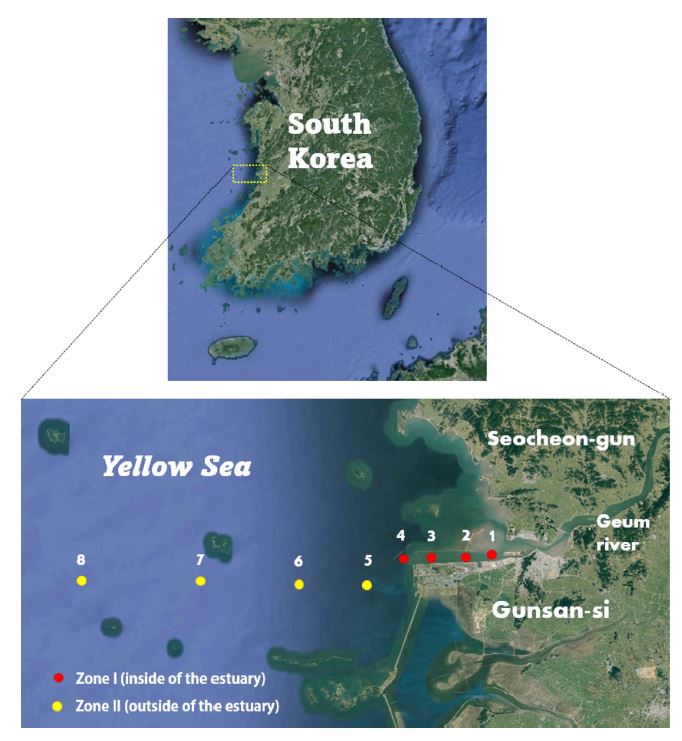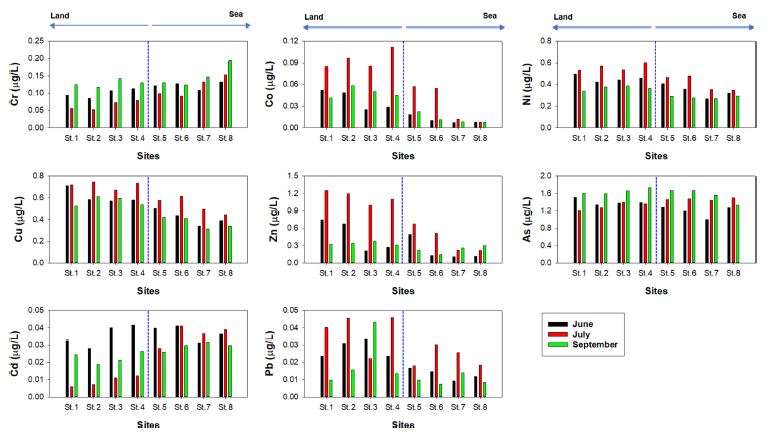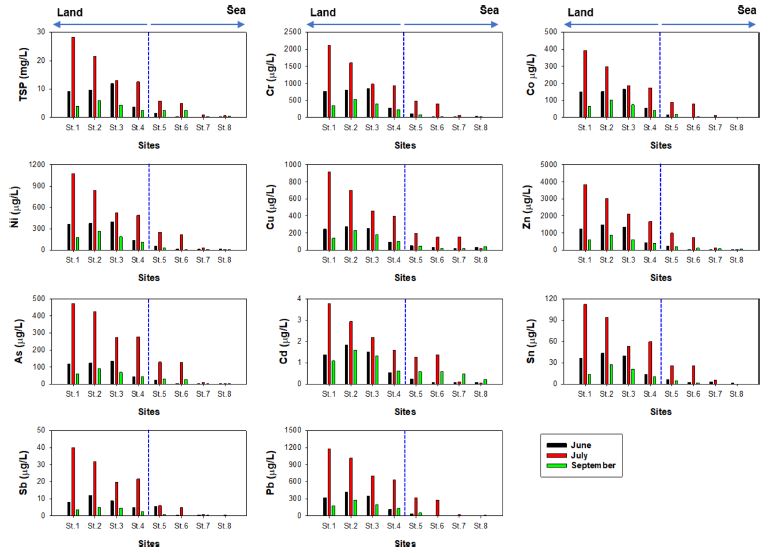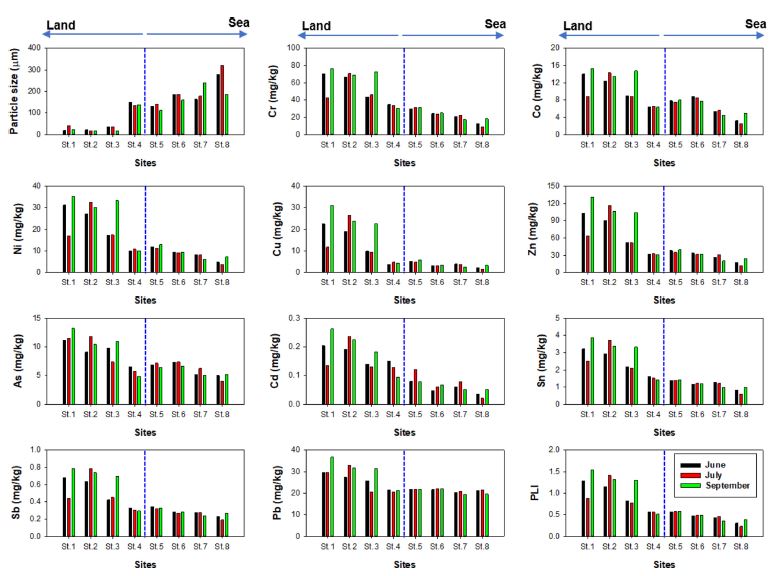
금강 하구역 해수 및 표층퇴적물 내 미량금속 분포 특성
초록
본 연구에서는 금강 하구역의 해수 및 표층퇴적물 내 미량금속의 시·공간적 분포 특성에 대한 조사를 수행하였다. 해수 및 퇴적물 내 Co, Ni, Cu, Zn, 및 Pb의 농도는 하구 내측에서 외측으로 갈수록 감소하는 경향을 나타냈으며, 하구역 내측의 미량금속 농도가 상대적으로 높은 뚜렷한 지역적 차이를 보였다. 강수량이 많았던 7월 조사에서 이들 해수 중 용존 형태와 입자형태(총부유물질) 내 미량금속의 평균농도는 다른 조사시기보다 높아, 금강 하구둑 방류로 인한 육상기인 입자와 및 비점오염원에 기인한 미량금속이 유출되고 있음을 알 수 있었다. 표층퇴적물의 경우, 7월 조사의 평균농도가 다른 조사시기에 비해 낮은 특징을 보였다. 7월 조사에서 퇴적물 입도의 평균은 131.6 μm로 다른 시기에 비해 큰 입자가 퇴적되어 있었다. 따라서 금강 하구둑을 통한 담수의 방류로 인해 하구역에서는 세립한 입자가 외측으로 제거되고 있음을 알 수 있었다. 총부유물질과 퇴적물 내 미량금속 오염도는 낮았으며, 미량금속 원소들 간의 좋은 상관관계가 존재하고 있었다. 이들 결과는 금강 하구역 주변에 존재하는 오염원(장항제련소, 군산 국가산업단지)보다는 강우로 인한 금강 하구둑을 통한 담수 유출의 강도가 금강 하구둑의 미량금속의 시·공간 분포에 주요하게 영향을 미치는 요인임을 시사한다.
Abstract
The spatial and temporal distribution characteristic of trace metals in seawater and surface sediments were investigated in the Geum River Estuary. Concentrations of Co, Ni, Cu, Zn, and Pb in seawater and sediments tended to decrease from inside of the Estuary to outer sea, showing distinct regional differences. In the July survey, where precipitation was relatively high, the mean concentrations of these metals in dissolved phase and total suspended particles (TSS) were higher than those of other surveys, indicating that terrestrial- and runoff-derived trace metals were discharged from Geum River. However, trace metal concentrations in surface sediments were higher in the September than in July. The mean particle size of sediments was 131.6 μm, and large particles were present compared to other sampling periods. Therefore, it was found that fine particles with a high concentration of trace metals were removed to the outer part of Estuary due to the discharge of Geum River. The overall contamination level of trace metals in TSS and surface sediments was very low, and there was a good positive correlation among trace metals. These results suggest that the discharge through the Geum River Bank due to precipitation rather than the pollution source existing around the Geum River Estuary is a factor that mainly affects the spatial-temporal distribution of trace metals.
Keywords:
Guem River Estuary, Trace metals, Surface sediment, Seawater, Spatio-temporal distribution키워드:
금강하구역, 미량금속, 표층퇴적물, 해수, 시공간분포1. 서 론
하구역은 육상과 해양환경을 연결하는 역할을 하며 금속, 영양염류, 잔류성 유기 오염물질과 같은 다양한 오염물질의 저장고이다(Haddout et al.[2022]). 하구 환경은 도시, 산업, 교통 및 농업과 같은 인위적인 활동에 의해 오염될 수 있으며(Niu et al.[2021]), 용존상 및 입자상 물질의 분배는 하구역에서 금속의 분포, 수송 및 거동에 중요한 역할을 한다(Petit et al.[2015]). 그러나 하구역에서의 금속 오염은 주로 퇴적물을 사용한 연구가 수행되었으며, 상대적으로 해수 중 용존 및 입자상 금속과 함께 연구한 사례는 많지 않다(La Colla et al.[2015]). 급격한 도시화 및 산업화로 인하여 금속 오염은 지난 수십년 동안 끊임없이 심각한 환경 오염 문제에 직면해 있다(Adnan et al.[2022]). 금속은 도시환경에서 배출되는 방류수 및 유출수는 강이나 하천을 통해 하구시스템으로 지속적으로 배출되어 주변 생태계에 유해한 영향을 미칠 수 있어(Jeong et al.[2020]; El-Amier et al.[2021]), 많은 국가에서 연안환경에서의 금속 오염을 제한하려는 노력을 하고 있다.
미량금속(trace metals)은 하구역을 포함한 해양환경에서 중요한 미량영양소이며, 수상식물과 생물 성장에 필수원소이다(Li et al.[2017]; Posacka et al.[2017]). 환경 내 미량금속의 농도가 너무 낮으면 생태계의 1차 생산을 제한하는 요인이 될 수도 있으며, 특정 임계값(threshold)를 초과하면 독성영향을 나타낸다(Herrero et al.[2014]; Maldonado et al.[2006]; Dong et al.[2015]). 하구역 내 미량금속은 담수를 통한 육상기원 물질의 유입, 염분구배, 조석 및 외측과의 혼합에 따라 분포하게 된다(Pan et al.[2020]). 염분이 적은 담수의 유입이 집중되는 하구역에서는 외해의 해수와 혼합되는 동안, 용존-입자 및 해수-퇴적물 간의 상호작용 시간적, 공간적인 변동성을 유발하게 된다.
금강하구역 주변에는 서천군과 군산시가 위치하며, 20개의 갑문을 포함한 약 1.8 km길이의 금강하구둑이 담수와 해수의 혼합을 제한하고 있다. 금강하구둑은 연간 365 백만 톤의 농업 및 공업 용수공급을 담당하고 하구둑 개방시 일부 지역이 침수되고 염분이 있는 해수의 유입으로 인한 피해발생의 우려로 인하여 홍수와 썰물시에만 제한적으로 개방하고 있다. 금강은 총 길이 397 km로 우리나라 주요한 강 중에 하나이다. 금강의 유역면적은 9,885 km2로 전체 유역에는 수많은 미량금속 오염원이 산재되어 있으며 하구역 주변에만 장항제련소, 국가산업단지, 군산시, 항만 등 미량금속 오염원이 다수 위치하고 있다. Lee et al.[2021]은 군산저수지 내 퇴적물 코어에서 미량금속과 납 동위원소를 분석하여 장항제련소 기인의 미량원소가 대기를 통해 퇴적되어 구리와 납의 오염되어 있는 것으로 보고하였다. 하구역은 강을 통한 육상기인의 미량금속이 해양으로 유입되는 물질순환과정 이해를 위하여 중요한 연구지역이다. 따라서 본 연구에서는 2020년 3회(6월, 7월 및 9월)에 걸쳐 금강하구역 내측과 외측에서 채취한 해수와 표층퇴적물 내 미량금속의 시·공간분포 특성과 오염현황에 대한 고찰을 실시하였다.
2. 재료 및 방법
2.1 해수, 표층 퇴적물 시료채취 및 전처리
본 연구에서는 금강 하구역 내측에서 외측까지 총 8개의 정점에서 2020년 6월 11일, 7월 15일 및 9월 15일 3회에 걸쳐 표층 해수와 표층 퇴적물을 채취하였다. 시료는 2개의 구역으로 나누어 금강하구역 내측 4개 정점(Zone I)과 외측 4개 정점(Zone II)에서 채취하였다(Fig. 1). 표층 해수는 선박에 의한 오염에 유의하며, PVC 막대에 산 세척된 1L 폴리에틸렌 시료병을 매달아 채취하였고, 채취 후 드라이 아이스로 즉시 냉동보관하였다. 표층 퇴적물은 Smith-McIntyre grab 샘플러를 이용하여 표층이 교란되지 않게 유의하며 상부 ~0.5 cm를 지퍼백에 옮겨 담아 표층 해수와 마찬가지로 실험실 운반을 위하여 냉동보관 하였다.

Sampling stations for seawater and surface sediments from the Geum River Estuary and outer sea (base map from Google Earth).
표층 해수는 크린룸(class 1000)에서 미리 고순도의 염산으로 산세척하고 무게가 측정된 0.4 μm (poresize) polycarbonate (PC) 재질의 필터(47 mm, Whatman)로 여과하여 용존 형태와 입자형태(총부유물질; total suspended particles, TSP)로 구분하였다. 여과된 해수는 고순도의 질산(Ultra, Kanto Chemical, Japan)을 가하여 pH를 1이하로 보관하였고, 여과 후 PC filter는 산 세척된 petridish에 옮겨 담아 테프론으로 코팅된 오븐에서 건조시킨 후 무게를 측정하고 분석시까지 보관하였다.
표층 퇴적물은 동결건조 후 자동분쇄기(planetary mono mill grinder, Pulverisette 6, Fritsch Co., Germany)로 분쇄 및 균질화 하였다. 퇴적물 입도는 분쇄하지 않은 퇴적물 시료 일부를 1N 염산과 과산화 수소로 무기탄소인 조개껍데기와 유기물을 제거한 후 한국 지질자원연구원에서 레이저 회절 입도분석기(Mastersizer 2000, Malvern Panalytical Ltd., UK)로 분석하였다.
2.2 해수 내 미량금속 분석
용존 해수 중 미량금속은 해수 분석에 가장 큰 방해물질인 높은 농도의 염분을 제거하고 컬럼으로 시료의 농축과정 등의 방법들이(direct, preconcentration, hydride modes) 자동화된 전처리 장비(seafast SP3, Elemental Scientific, USA)와 결합된 유도결합 플라즈마 질량분석기(ICP-MS, Nexion 2000, Perkin Elmer, USA)로 분석하였다(Jeong et al.[2019]). 분석의 정확도 검증을 위하여 2가지 해수 인증표준물질(CASS-6와 NASS-6, NRCC)을 이용하여 미량금속(As, Cr, Co, Ni, Cu, Zn, Cd, Pb)를 분석하였으며, CASS-6(n=12)와 NASS-6(n=12)의 회수율은 각각 91.3%(As)~98.8%(Cu)와 93.2%(Zn)~105.3%(Cr)로 인증값과 일치하는 결과를 얻었다.
2.3 해수 중 부유입자 및 퇴적물 내 미량금속 분석
입자가 포함된 PC filter와 분쇄된 퇴적물은 시료의 무게를 측정한 후 테프론 시료분해용기에 넣고 고순도의 불산(Suprapure, Merck Co., Germany), 질산(Ultra-100, Kanto Chemical, Japan), 과염소산(Suprapure, Merck Co., Germany)를 첨가하고 흑연블럭 시료전처리 장비(핫플레이트)에서 185 oC로 48시간 완전분해하였다(Jeong et al.[2020]). 완전분해 된 시료는 증발건고 후 2% 질산으로 재용해 시킨 후 시료 종류 및 분석하고자 하는 미량금속에 따라 희석배수를 달리하여 유도결합플라즈마 질량분석기(ICP-MS, iCAP-Q, Thermo Scientific, Germany)로 As, Cr, Co, Ni, Cu, Zn, Sn, Sb, Cd 및 Pb를 분석하였다. 용존 해수와 마찬가지로 분석된 자료의 검증을 위하여 2가지 종류의 해양퇴적물 인증표준물질은 MESS-4(n=12)와 PACS-3(n=12)를 시료와 함께 처리하여 분석하였다. 분석결과 MESS-4는 94.7%(Cr)~103.5%(Sn) PACS-3는 97.4%(Ni)~104.3%(Pb)로 보고된 값에 부합되는 결과를 얻었다.
2.4 퇴적물 내 중금속 오염도 평가
3회의 조사시기와 시료채취 지점에 따른 퇴적물 내 미량금속 각각의 오염도를 평가하기 위하여 농집지수(geo-accumulation index; Igeo)와 종합적인 오염도 평가를 위하여 오염부하지수(pollution load index; PLI)를 사용하였다(Muller[1969]; Tomlinson et al.[1980]).
여기서, Cn과 Bn은 각각 본 연구에서 분석된 퇴적물 내 미량금속 농도(mg/kg)와 배경농도(Rudnick and Gao[2003])를 나타낸다. PLI는 본 연구에서 분석된 10개의 미량금속에 대한 종합 오염을 평가하였으며, 1보다 큰 값은 인위적인 오염이 존재하는 것을 의미한다.
3. 결과 및 고찰
3.1 용존 미량금속의 시공간적 변동 특성
금강 하구역 표층 해수 내 용존 미량금속의 공간 분포는 Fig. 2에 나타냈다. Cr은 3회의 조사시가 모두 하구역에서 외측으로 갈수록 농도가 증가하고 있었다. Co, Ni, Cu, Zn 및 Pb은 하구역 내측 정점(Zone I; St. 1~4)상대적으로 높은 농도를 보였으며, 외측에서는 농도가 점차적으로 감소하고 있었다. As는 공간적으로 뚜렷한 농도의 증감이 없었다. Cd는 7월과 8월 조사에서만 외측에서 상대적으로 높은 농도를 가지는 것으로 나타났다.

Comparison of the spatial distributions of dissolved trace metals (μg/L) in surface seawater at the Geum River Estuary and outer sea during three sampling periods.
조사시기에 따른 용존 미량금속의 평균농도 비교는 Table 1에 나타냈다. Co, Ni, Cu, Zn 및 Pb는 하계인 7월 조사에서의 평균이 다른 조사시기에 비해 높았으며, 특히 Co, Zn 및 Pb의 농도는 7월 조사가 다른 조사시기에 비해 큰 폭으로 증가한 것으로 나타났다. 조사 이전 3일간의 총 강우량은 6월 조사가 39.6 mm, 7월 조사가 211 mm, 9월 조사가 3.5 mm이었다. 홍수시 금강 하구둑의 개방으로 인한 금강하구둑 내측에서 많은 양의 담수기원의 미량금속이 공급된 것으로 판단된다. As와 Cr은 9월 조사에서 Cd은 6월 조사에서 상대적으로 평균농도가 높은 특징을 보였다. 7월 조사에서 해수 중 용존 미량금속은 As가 1.39 μg/L로 가장 높았으며, Zn>Cu>Ni>Cr>Co>Pb>Cd의 농도순으로 원소에 따라 약 61배의 농도차이가 존재하였다.

Comparison of mean values for dissolved trace metals (μg/L) in surface seawater in the Geum River Estuary and outer sea and those in the other published data
금강 하구역 내측과 외측으로 지역을 나누어 미량금속 농도를 비교한 결과, 금강 하구역 내측(Zone I)이 외측(Zone II)에 비해 Co, Ni, Cu, Zn 및 Pb은 1.3~3.2배 평균농도가 높았다(Table 1). As는 하구역 내측과 외측간의 차이가 크지 않았으며, Cr과 Cd는 하구역 외측이 내측보다 각각 1.3배와 1.5배 높은 특징을 보였다. 본 연구에서 분석한 8개 용존 미량금속간의 상관성을 Table 2에 나타냈다. Cr은 Co, Ni, Cu, Zn 및 Pb와 통계적으로 유의한 음(-)의 상관성을 보였다. 하구역 내측이 외측보다 평균농도가 높았던 미량금속(Co, Cu, Ni, Zn 및 Pb)간에는 양(+)의 상관성이 존재하였으며, As는 다른 금속들과 상관성이 없는 것으로 나타났다.
금강 하구역 내 용존 미량금속의 평균농도는 Co, Zn 및 Pb는 경기만에 비해 약간 높은 특징을 보였으나, Cd는 금강하구역이 마산만 보다 높은 것을 알 수 있었다(Table 1). 국내 다른 연구지역과 황해의 북측에 비해 평균 농도가 낮은 결과를 보였다.
3.2 총부유물질 내 미량금속의 시공간적 변동 특성
표층 해수 중 총부유물질 내 미량금속의 공간적인 분포특성과 평균농도 비교는 각각 Fig. 3과 Table 3에 나타냈다. 7월 조사에서 총 부유물질의 평균 및 농도범위는 각각 11.0 mg/L와 0.6~28.2 mg/L로 하구역의 가장 내측 정점에서 가장 높은 총부유물질 농도를 보여, 하구둑을 통한 육상기인 부유물질의 양이 많았던 것으로 판단된다. 강우량이 가장 많았던 7월 조사에서 총부유물질 내 미량금속 역시 다른 조사시기에 비해 크게 농도가 크게 증가하였으며, 모든 조사시기에서 하구역 외측에서는 큰 폭으로 농도가 감소하였다. 7월 총부유물질 내 미량금속의 경우, Zn가 1,574 μg/L로 평균농도가 가장 높은 원소였으며, Cr>Pb>Ni>Cu>As>Co>Sn>Sb>Cd의 농도순으로 나타났다.

Comparison of the spatial distributions in trace metals (μg/L) in TSP of surface seawater from the Geum River Estuary and outer sea.

Comparison of mean values for trace metals concentrations in total suspended particles (TSP; μg/L) and surface sediments (mg/kg) from the Geum River Estuary and outer sea and those in the other published data.
용존 미량금속과 마찬가지로, 금강 하구역 내측 지역(Zone I)에서 총 부유물질 내 미량금속의 평균농도는 3.9(Cd)~8.1(Co)배 외측(Zone II)에 비해 높았다. 비소를 제외한 대부분의 미량금속이 해수 내 입자의 형태로 존재하는 것을 알 수 있었다. 총부유물질 및 부유물질 내 미량금속은 모두 유의한 양(+)의 상관성을 보여, 강우시 금강 하구둑을 통해 유출되는 방류수의 영향을 크게 받고 있는 것을 알 수 있었다. 미량금속 중에는 교통활동과 밀접한 관련이 있는 Sb가 7월 조사시기에서 농도가 높아, 금강 유역에 존재하는 도시주변에서 발생한 비점오염물질이 하구둑을 통해 하구역으로 유입된 것을 시사하고 있다.
3.3 표층퇴적물 내 미량금속의 시공간적 변동 특성
표층퇴적물 내 미량금속의 공간분포 특성은 Fig. 4에 나타냈다. 퇴적물 중 평균입도는 6월 123.2 μm, 7월 131.6 μm, 9월 111.8 μm로 강우량이 많은 7월에 입자가 큰 퇴적물이 퇴적되어 있으며, 외측으로 갈수록 퇴적물 입자의 크기가 증가하고 있었다. 표층퇴적물 내 입도는 금강하구역 내측에서는 54.1 μm의 평균으로 외측의 190.6 μm에 비해 세립한 퇴적물이 우세하였다. 해수 총부유물질 내 미량금속 농도와 마찬가지로 하구역 내측에서 외측으로 갈수록 표층퇴적물 내 미량금속 농도는 감소하고 있었다. 그러나 퇴적물 내 미량금속의 평균농도는 모든 원소가 9월이 상대적으로 높은 것으로 나타났다. 9월 조사에서는 조사 이전의 강우량이 적어, 썰물 시 하구둑 개방으로 인한 방류된 미량금속들이 하구둑 내측에 퇴적되어 있는 것을 알 수 있었다. 금강하구역과 외측 퇴적물 내 미량금속 농도는 낙동강, 태화강 하구역, 중국의 양쯔강 하구역에 비해 낮았으며, 황해의 동측과 남측 해역에 비해서도 농도가 낮은 특징을 보였다(Table 3).

Comparison of the spatial distributions of trace metals (mg/kg) in the surface sediment from the Geum River Estuary and outer sea.
표층퇴적물 입도와 미량금속 간에는 통계적으로 유의한 음(-)의 상관성을 보였으며, 미량금속 원소가 양(+)의 상관성 결과를 통해, 금강 하구역 표층퇴적물 내 미량금속의 농도를 조절하는 요인은 주변환경을 통한 인위적인 오염원의 유입보다는 입도조성인 것을 알 수 있었다(Table 4). 해수 내 미량금속 농도가 높았던 7월 조사시기에 표층퇴적물 내 낮은 미량금속 농도는 홍수시에 개방되는 금강 하구둑을 통해 많은 양의 담수가 공급되어 작은 입자의 퇴적물을 외측으로 운반되어 상대적으로 입자가 큰 퇴적물이 남아 있었기 때문으로 판단된다. 농집지수(Igeo)를 이용한 오염도 평가는 금강하구역 외측(Zone II)은 모두 Igeo 값이 음(-)의 값으로 오염되지 않은 나타났다. 하구역 내측(Zone I)에서는 As, Cd, Pb 등의 Igeo 값의 평균인 0.1~0.3으로 나타나, 오염되지 않음에서 약간 오염된(unpolluted to moderately polluted) 등급에 해당되는 오염상태를 보였다(Table 5). 본 연구에서 분석된 10개 미량원소의 종합적인 오염도를 나타내는 오염부하지수(PLI)는 금강 하구역 내 일부 정점들(St. 1~3)에서만 1초과하고 있어, 인위적인 오염이 다소 존재함을 알 수 있었다(Fig. 4). 모든 조사시기와 정점에서 국내 해저퇴적물 주의 기준(threshold effect levels; TEL) 이하로 퇴적물 내 미량금속 농도가 저서생태계에 부정적인 영향을 주지 않는 것으로 나타났다.
4. 결 론
육상유역에서 발생한 미량금속 등의 오염물질은 강이나 하천을 통해 점오염원 및 비점오염형태로 하구역을 포함한 연안환경으로 배출되며, 하구역은 이들 미량금속의 1차 저장고이자, 물리적인 환경변화에 의해 외측을 운반하는 역할을 하고 있다. 본 연구를 통해 금강 하구역 용존 해수, 총부유물질 및 표층퇴적물 내 미량금속의 농도는 하구역 내측에서는 높고 외측으로 갈수록 감소하는 것으로 나타났다. 해수 내 미량금속은 강우량이 높았던 하계 조사에서 일부 미량금속들의 농도가 급격하게 증가하고 있어, 금강하구둑 일시개방으로 인하여 육상유역에서 발생한 미량금속들이 하구역을 통해 외측으로 유출되고 있음을 알 수 있었다. 표층퇴적물 내 미량금속은 인위적인 인간활동에 의한 오염보다는 입도에 영향을 크게 받는 것으로 나타났고, 국내 주의기준 이하의 낮은 오염상태를 보였다. 하구역 환경 내 미량금속 분포는 대기를 통한 유입, 담수와 해수수괴의 혼합이 영향도 존재하지만 연구지역에서는 금강하구둑을 통한 담수 유출의 세기와 빈도에 주로 영향을 받고 있음을 알 수 있었다.
Acknowledgments
본 연구는 한국해양과학기술원 연구사업(PEA0013)에 의해 수행되었습니다. 논문의 완성도 향상을 위하여 유익한 조언을 해 주신 익명의 심사위원들께 감사드립니다.
References
-
Adnan, M., Xiao, B., Xiao, P., Zhao, P. and Bibi, S., 2022, Heavy metal, waste, COVID-19, and rapid industrialization in this modern era—Fit for sustainable future. Sustainability 14, 4746.
[https://doi.org/10.3390/su14084746]

-
Dong, Y., Rosenbaum, R.K. and Hauschild, M.Z., 2015, Assessment of metal toxicity in marine ecosystems: comparative toxicity potentials for nine cationic metals in coastal seawater. Environ. Sci. Technol. 50, 269-278.
[https://doi.org/10.1021/acs.est.5b01625]

-
El-Amier, Y.A., Bessa, A.Z.E., Elsayed, A., El-Esawi, M.A., AL-Harbi, M.S., Samra, B.N. and Kotb, W.K., 2021, Assessment of the heavy metals pollution and ecological risk in sediments of Mediterranean Sea drain estuaries in Egypt and phytoremediation potential of two emergent plants. Sustainability 13, 12244.
[https://doi.org/10.3390/su132112244]

-
Haddout, S., Priya, K.L., Cecilia, J., Casila, C. and Samad, B., 2020, Assessment of heavy metal contamination in the surficial sediments from the Sebou River Estuary, Morocco. Environ. Forensics 23(1-2), 23-31.
[https://doi.org/10.1080/15275922.2021.1887970]

-
Herrero, E., Arancibia, V. and Rojas-Romo, C., 2014, Simultaneous determination of Pb2+, Cd2+ and Zn2+ by adsorptive stripping voltammetry using Clioquinol as a cleating-adsorbent agent. J. Electroanal. Chem. 729, 9-14.
[https://doi.org/10.1016/j.jelechem.2014.06.039]

-
Hwang, D.W., Lee, I.S., Choi, M., Kim, C.S. and Kim, H.C. 2015, Evaluation of pollution level for organic matter and trace metals in sediments around Taehwa River Estuary, Ulsan. Korean J. Fish Aquat. Sci. 48(4), 542-554.
[https://doi.org/10.5657/KFAS.2015.0542]

-
Jeong, H., Choi, J.Y., Lee, J., Lim, J. and Ra, K., 2020, Heavy metal pollution by road-deposited sediments and its contribution to total suspended solids in rainfall runoff from intensive industrial areas. Environ. Pollut. 265, 115028.
[https://doi.org/10.1016/j.envpol.2020.115028]

-
Jeong, H., Lee, J., Choi, J.Y., Kim, K.T., Kim, E.S., Sun, C., Park, J.K. and Ra, K., 2019, Study on dissolved and particulate heavy metals in stream water and stormwater runoff from Suyeong watershed in Busan special management area, Korea. J. Korean Soc. Mar. Environ. Energy 22(4), 203-214.
[https://doi.org/10.7846/JKOSMEE.2019.22.4.203]

-
La Colla, N.S., Negrin, V.L., Marcovecchio, J.E. and Botté, S.E., 2015, Dissolved and particulate metals dynamics in a human impacted estuary from the SW Atlantic. Estuar. Coast. Shelf Sci. 166, 45-55.
[https://doi.org/10.1016/j.ecss.2015.05.009]

- Lee, J., Yang, C., Han, K. and Lee, T., 2020, Estimation of heavy metal contamination level in Masan Bay and Nakdong estuary sediments. J. Korean Geo-Environ. Soc. 21(3), 13-21.
-
Lee, P.K., Lim, J., Jeong, Y.J., Hwang, S., Lee, J.Y. and Choi, B.Y., 2021, Recent pollution and source identification of metal(loid)s in a sediment core from Gunsan Reservoir, South Korea. J. Hazard. Mat. 416, 126204.
[https://doi.org/10.1016/j.jhazmat.2021.126204]

-
Li, L., Wang, X.J., Liu, J.H. and Shi, X.F., 2017, Dissolved trace metals (Cu, Cd, Co, Ni, and Ag) distribution and Cu speciation in the southern Yellow Sea and Bohai Sea, China. J. Geophys. Res. Oceans. 122, 1190-1205.
[https://doi.org/10.1002/2016JC012500]

-
Maldonado, M.T., Allen, A.E., Chong, J.S., Lin, K., Leus, D., Karpenko, N. and Harris, S.L., 2006, Copper-dependent iron transport in coastal and oceanic diatoms. Limnol. Oceanogr. 51, 1729-1743.
[https://doi.org/10.4319/lo.2006.51.4.1729]

- Muller, G., 1969, Index of geoaccumulation in sediments of the Rhine River. GeoJournal 2, 108-118.
-
Niu, L., Cai, H., Jia, L., Luo, X., Tao, W., Dong, Y. and Yang, Q., 2021, Metal pollution in the Pearl River Estuary and implications for estuary management: The influence of hydrological connectivity associated with estuarine mixing. Ecotoxicol. Environ. Saf. 225, 112747.
[https://doi.org/10.1016/j.ecoenv.2021.112747]

-
Pan, D., Ding, X., Han, H., Zhang, S. and Wang, C., 2020, Ra, K., Kim, E.S., Kim, K.T., Kim, J.K., Lee, J.M. and Choi, J.Y., 2013. Assessment of heavy metal contamination and its ecological risk in the surface sediments along the coast of Korea. J. Coast. Res. SI65, 105-110. Species, spatial-temporal distribution, and contamination assessment of trace metals in typical mariculture area of North China. Front. Mar. Sci. 7, 552893.
[https://doi.org/10.3389/fmars.2020.552893]

-
Park, S., Choi, M., Jang, D., Joe, D. and Park, K., 2020a, Distribution and sources of dissolved and particulate heavy metals (Mn, Co, Ni, Cu, Zn, Cd, Pb) in Masan Bay, Korea. Ocean Sci. J. 55(1), 49-67.
[https://doi.org/10.1007/s12601-020-0001-2]

-
Park, S., Choi, M., Jang, D., Joe, D., Park, K., Lee, H., Woo, J., Kim, T. and Park, J., 2020b, Spatiotemporal distribution of dissolved heavy metals in Gyeonggi Bay, Korea. Ocean Sci. J. 55(1), 69-84.
[https://doi.org/10.1007/s12601-020-0002-1]

-
Petit, J.C.J., Schäfer, J., Coynel, A., Blanc, G., Chiffoleau, J.F., Auger, D., Bossy, C., Derriennic, H., Mikolaczyk, M., Dutruch, L. and Mattielli, N., 2015, The estuarine geochemical reactivity of Zn isotopes and its relevance for the biomonitoring of anthropogenic Zn and Cd contaminations from metallurgical activities: Example of the Gironde fluvial-estuarine system, France. Geochim. Cosmochim. Acta 170, 108-125.
[https://doi.org/10.1016/j.gca.2015.08.004]

-
Posacka, A.M., Semeniuk, D.M., Whitby, H., van den Berg, C.M.G., Gullen, J.T., Orians, K. and Maldonado, M.T., 2017, Dissolved copper (dCu) biogeochemical cycling in the subarctic Northeast Pacific and a call for improving methodologies. Mar. Chem. 196, 47-61.
[https://doi.org/10.1016/j.marchem.2017.05.007]

-
Ra, K., Kim, J.K., Kim, K.T., Lee, S.Y., Kim, E.S., Lee, J.M. and Wu, R.S.S., 2014, Application of the artificial mussel for monitoring heavy metal levels in seawater of the coastal environments, Korea. J. Korean Soc. Mar. Environ. Energy 17(2), 131-145.
[https://doi.org/10.7846/JKOSMEE.2014.17.2.131]

-
Rudnick, R.I. and Gao, S., 2003, Composition of the continental crust. In: Rudnick, R.L., editor. The Crust, Elsevier, pp. 1-64.
[https://doi.org/10.1016/B0-08-043751-6/03016-4]

- Sun, C.I., Park, G.W., Park, H.S., Park, J.K., Kim, S.G. and Choi, M.S., 2018, Distribution of heavy metal concentrations in surface sediments of the eastern Yellow Sea. J. Korean Soc. Oceanogr. 23(4), 179-191.
- Tian, L., Chen, H., Du, J.T. and Wang, X.H., 2009, Factors influencing distribution of soluble heavy metals in north yellow sea surface seawaters. Period. Ocean. Univ. Chin. 39, 617-621.
-
Tomlinson, D.L., Wilson, J.G., Harris, C.R., Jeffrey, D.W., 1980, Problems in the assessment of heavy-metal levels in estuaries and the formation of a pollution index. Helgol. Meeresunters. 33, 566-575.
[https://doi.org/10.1007/BF02414780]

-
Xu, F., Hu, B., Yuan, S., Zhao, Y., Dou, Y., Jiang, Z. and Yin X. 2018, Heavy metal in surface sediments of the continental shelf of the South Yellow Sea and East China Sea: Sources, distribution and contasmination. Cantena 160, 194-200.
[https://doi.org/10.1016/j.catena.2017.09.022]

-
Wang, H., Wang, J., Liu, R., Yu, W. and Shen, Z. 2015, Spatial variation, environmental risk and biological hazard assessment of heavy metals in surface sediments of the Yangtze River estuary. Mar. Pollut. Bull. 93(1-2), 250-258.
[https://doi.org/10.1016/j.marpolbul.2015.01.026]

